Posted by Anita on 03.29.10 8:19 AM
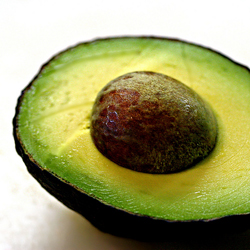 The first glimmers of spring are showing up at the farmers market, just as we’re on the home stretch of the Dark Days Challenge, and boy are we excited. Not so much for the strawberries; they’re still white in the center, and I’ll happily wait until they’re fully ripe. But we’re gorging ourselves on the new, tender asparagus, and we’re definitely making up for lost time in the avocado department.
The first glimmers of spring are showing up at the farmers market, just as we’re on the home stretch of the Dark Days Challenge, and boy are we excited. Not so much for the strawberries; they’re still white in the center, and I’ll happily wait until they’re fully ripe. But we’re gorging ourselves on the new, tender asparagus, and we’re definitely making up for lost time in the avocado department.
We put up jars of salsa last summer to help get us through the bleak winter months — without tomatillos, tomatoes, or chile peppers, Mexican food becomes downright impossible. But avocados defy preserving, and even on those rare occasions when we break down and buy an out-of-season avocado or two (sometimes it’s a guacamole emergency, I tell ya!) we always remember why it pays to wait. The watery, wan specimens that make their way here from Mexico or Chile just can’t compare with Will’s buttery, nutty avocados. So we wait. And wait. And wait. Rather impatiently, I might add. It’s one of the few winter deprivations that actually makes me cranky.
And so this week, we celebrated the avocado’s return to our kitchen with a big mess of tacos. It’s another one of those shopping-not-cooking recipes: Once you’ve got all the ingredients on hand, it’s a little bit of chopping, and a whole lot of gobbling. And should you have any leftovers, I can vouch that this filling, along with perhaps a little cheese and a soft-scrambled egg or two, makes an exceptional breakfast taco.





Chorizo-Potato-Mushroom Tacos
– adapted from Mexico One Plate at a Time
2 medium waxy potatoes (about 1/2 pound)
1/2 pound Mexican chorizo
1/4 to 1/2 pound mushrooms, any variety, sliced
1 small white onion, diced
1/2 cup or more tomatillo salsa (homemade or store-bought)
1 ripe avocado
6 to 8 fresh tortillas
Cube the potatoes and simmer in a pot of salted water until tender; drain and set aside in a medium bowl.
Saute the chorizo and onion in a wide skillet over medium heat until the sausage is cooked through. Using a slotted spoon, remove the sausage and onions to the bowl with the potatoes, leaving the rendered fat in the pan. Add the mushrooms to the pan and saute until softened and beginning to brown. Return the potatoes and chorizo-onion mixture to the pan and cook until the potatoes begin to brown.
Meanwhile, thoroughly mash the avocado in a bowl, then add the tomatillo salsa. Add more salsa until the mixture is like a sauce. Season with salt as needed.
Warm the tortillas in a skillet or griddle, or by running them over an open flame. Wrap them in a towel as you go, to keep them warm for the table. When tortillas are all warmed, move the taco filling to a serving bowl, and bring to the table with the avocado salsa and the warm tortillas. Let each person build their own tacos at the table with a scoop of the filling and a drizzle of the salsa in the middle of each tortilla.
 Farmers and food artisans who created the ingredients for this week’s meal:
Farmers and food artisans who created the ingredients for this week’s meal:
Little Organic Farm, Marin: potatoes
Fatted Calf, Napa: chorizo
Far West Fungi, Moss Landing: mushrooms
Catalán Family Farm, Hollister: onion
Will’s Avocados, Soledad: Avocados
La Palma Mexicatessen, San Francisco: fresh tortillas
…and our own home-preserved tomatillo salsa
Dark Days challenge, locavore, meat, Mexican, recipes
6 Comments »




Posted by Anita on 02.07.10 9:16 PM
 Yes, yes — soup again. I’d really hoped to have something better to share by the end of the week, but I’m still fighting the after-effects of a particularly nasty cold. Making dinner is doubly complicated: Not only do I not feel much like cooking, but I often have to trick myself into eating something I’m craving before my appetite disappears again.
Yes, yes — soup again. I’d really hoped to have something better to share by the end of the week, but I’m still fighting the after-effects of a particularly nasty cold. Making dinner is doubly complicated: Not only do I not feel much like cooking, but I often have to trick myself into eating something I’m craving before my appetite disappears again.
Early last week, the only thing I could really get worked up about making was tortilla soup. We’re still at least a month away from local avocados at our farmers market, but I couldn’t imagine this classic soup without them. Sometimes it’s worth it, I rationalized, to make an exception for an ingredient that has no reasonable local alternative.
As luck would have it, Cameron found semi-local organic avocados at our co-op — California is better than Mexico, right? And we have plenty of local tomatoes in the pantry, so I didn’t have to venture too far off the local path to satisfy my sick-kid whims.





Sopa Azteca / Tortilla Soup
– adapted from Mexican Everyday
2 cups diced tomatoes in juice
2T ground pasilla or ancho chile
2T chicken fat (or mild vegetable oil)
3 garlic cloves, peeled
2 quarts chicken broth
1 large sprig epazote (optional)
2-1/2 cups cooked chicken, chopped or shredded
1 large ripe avocado, pitted, skinned, and cubed
6oz (about 1-1/2 cups) shredded mild cheese, such as asadero, Jack, etc.
6oz (about 4 cups) broken tortilla chips
1 large lime, cut into 6 wedges
Preheat the broiler. Drain the tomatoes, reserving the juice, and place on a parchment-lined rimmed cookie sheet. Broil the tomatoes until beginning to blacken; turn with a spatula and cook a little longer on the other side, until toasted and aromatic. Remove from oven and set aside.
Melt the chicken fat in a medium saucepan over medium-high heat. Add the onion and garlic and saute until softened. Add the ground chile and cook for another minute or two; be careful not to burn the chile — add water and/or adjust the heat if you smell it getting too hot. Remove the vegetables from the pan with a slotted spoon, leaving behind as much of the fat as possible, and transfer to the blender. Process until smooth, adding only as much of the tomato juice as you need to get a puree going.
Return the pan with the fat to medium-high heat. When hot, add the puree and stir constantly until the puree is thickened to a paste. Puree the roasted tomatoes and the reserved tomato juice, and add them to the pot along with the broth and the epazote. Bring the soup just to a boil, then reduce heat to medium-low and simmer for 15 minutes. Taste and season with salt. Add the chicken to the simmering broth and heat through.
Divide the avocado, cheese, and tortilla chips between four individual bowls. Serve the lime wedges separately at the table.
 Farmers and food artisans who created the ingredients for this week’s meal:
Farmers and food artisans who created the ingredients for this week’s meal:
Tierra Vegetables, Santa Rosa: chile powder and garlic
Soul Food Farm, Vacaville: chicken
Spring Hill Cheese Company, Petaluma: Jack cheese
Primavera, Sonoma: Corn tortillas (for homemade tortilla strips)
Mariquita Farm, Watsonville: limes
…and our own home-canned chicken stock and tomatoes, and homegrown epazote
Exemption: avocado (California organic)
Dark Days challenge, locavore, Mexican, recipes
5 Comments »




Posted by Anita on 01.17.10 8:57 PM
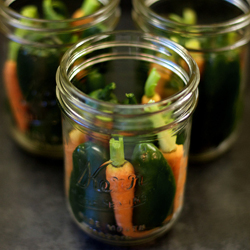 I really didn’t intend to feature yet another Mexican stew this week, but it’s inadvertently turned into a south-of-the-border comfort food month at our house. We had something entirely different planned for this week’s Dark Days Challenge meal, but our schedule got scrambled — by good things — so our fallback plan moved into the spotlight.
I really didn’t intend to feature yet another Mexican stew this week, but it’s inadvertently turned into a south-of-the-border comfort food month at our house. We had something entirely different planned for this week’s Dark Days Challenge meal, but our schedule got scrambled — by good things — so our fallback plan moved into the spotlight.
Because we’re so addicted to Latin flavors, we put up many of the necessary ingredients in the summer, at the height of their season. For this recipe, we used roasted, skinned tomatillos that we froze in bags, plus jalapeño peppers pickled in a traditional salty brine. Our cilantro’s wintered over quite well, so we don’t even have to claim exemptions this week.
This bean-enriched variation on chile verde isn’t a particularly beautiful dish, but it’s delicious. If you want to make it in the slow cooker, the original recipe omits the stock and layers all of the ingredients in the crock — starting with the tomatillos, followed by the rest of the vegetables, and the pork at the top. Cover and slow-cook on high for 6 hours, then add the cooked beans just before serving.





Puerco en Salsa Verde – Tomatillo Pork Braise with White Beans
– adapted from Mexican Everyday
1 to 1-1/4 pounds boneless pork shoulder, cut into 2-inch cubes
1 pound tomatillos
3 pickled jalapeños (divided use)
1 medium white or red onion, diced (divided use)
2 garlic cloves
1/3 cup loosely packed rough-chopped cilantro (divided use)
2 cups chicken or pork stock
2 cups cooked cannellini beans, drained
Mexican crema, sour cream, or creme fraiche, as desired
Salt the pork cubes, and set aside. Husk the tomatillos, then rinse and cut into quarters. Stem and halve the jalapeños, cut them in half, and scrape out the seeds; dice one of the chiles and set aside for garnish.
Heat oil or drippings in a large saucepan or small Dutch oven over medium heat. When shimmering, add the pork in a single layer and saute until golden brown on all sides. Remove the browned meat to a clean plate. Add about 2/3 of the diced onion to the pan and saute until soft. Add the garlic and continue to cook until garlic is golden. Add the jalapeños and half of the cilantro and cook until just soft. Add the prepared tomatillos and jalapenos, and return the meat to the pan. Add enough of the stock to come a little more than halfway up the side of the pork. Cover and simmer gently, 3 hours or more until the pork is tender, adding more stock as needed to keep the meat partly submerged.
When the pork is thoroughly tender, remove the meat to a clean plate with tongs. Puree the sauce with an immersion blender (or in batches — carefully — in a standard blender; then return to pan). Return the meat to the pan, and add the cooked beans. Taste and season with salt as needed, adding more stock or water to keep the sauce at the consistency of a creamy soup. Bring the dish to a simmer and serve warm, with remaining cilantro, onions, pickled jalapeños, and crema for garnish.
Farmers and food artisans who created the ingredients for this week’s meal: 
Marin Sun Farms, Point Reyes: pork shoulder
Catalán Family Farm, Hollister: tomatillos, onion, jalapeños
Iacopi, Half Moon Bay: garlic
Rancho Gordo, Napa: cannellini beans
Bellwether Farms, Sonoma: crème fraiche
Guisto’s Vita-Grain, South San Francisco: sea salt
…and our own homegrown cilantro and homemade pork stock
Dark Days challenge, locavore, Mexican, recipes
6 Comments »




Posted by Anita on 01.10.10 10:01 PM
 To take the chill out of winter, I like to make a big pot of pozole, the traditional Mexican pork stew. It’s one of those meals that leaves you feeling warm inside, even hours after you’ve finished dinner. I was feeling deprived that I hadn’t gotten around to it yet; I’d been waiting for a lazy weekend to appear, when a long Saturday might give me enough time to tackle the various steps.
To take the chill out of winter, I like to make a big pot of pozole, the traditional Mexican pork stew. It’s one of those meals that leaves you feeling warm inside, even hours after you’ve finished dinner. I was feeling deprived that I hadn’t gotten around to it yet; I’d been waiting for a lazy weekend to appear, when a long Saturday might give me enough time to tackle the various steps.
I’d bought the hominy and the dried chiles, even squirreled away a particularly meaty piece of pork, but didn’t get around to actually putting the stew together until it was time to make this week’s Dark Days Challenge meal.
Pozole verde, the version made with tomatillos and green chiles, is a staple in our house. But the deeper, complex brick-colored rojo style isn’t something we’ve made as often. Local dried chiles are significantly more expensive than the fresh varieties, but in the winter, when cooking with green chiles means dipping into our precious freezer stash, it doesn’t seem so profligate to splurge on a few dried anchos.
Steve Sando — who knows a few things about new-world grains — says that “in America, the [prepared] corn and the finished dish are called posole. In Mexico, only the finished dish is called pozole.” But I’m not fussy. Green or red, with an S or with a Z… I’m an equal opportunity pozole-loving fool.
Pozole is typically fiesta fare, so most recipes serve a crowd. At the moment, we’re short on freezer space, so we scaled this recipe to make just one dinner for two plus a pair of lunch-sized leftovers.
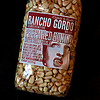

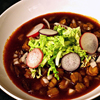


Pozole Rojo – Red Pork and Hominy Stew
– adapted from Mexico One Plate at a Time
1/2 pound dried corn prepared for pozole (such as Rancho Gordo White Corn Posole)
5 cloves garlic, peeled and halved
1 meaty piece of bone-in pork, about 1.5 pounds
– (we used shank; shoulder steaks are also good)
1 small pork trotter
1 white onion, chopped (divided use)
3 medium ancho chiles, stemmed and seeded
2 cups shredded green cabbage
5 radishes, sliced
1T dry Mexican oregano
2 tsp ground dried hot chile (optional, to taste)
thick tortilla chips or tostadas
In a large pot, combine 2 quarts of water with the hominy and garlic. Bring to a boil; partially cover the pot and simmer gently until the corn is thoroughly tender, 2 to 3 hours; many will split open. Season with salt and cool in the liquid.
While the corn simmers, place the pork and trotter in another pot; cover with water, add 2 tsp salt, and bring to a boil. Skim off any foam that rises to the surface, then add half of the chopped onion. Simmer over medium-low heat, partially covered, until all of the meat is tender, at least 2 hours. Cool the meat in the broth, then remove it to a plate. Skim the fat from the broth, or cool overnight and remove the solidified fat the next morning. You should have about 3 cups of broth. Pull the meat off the bones and chop into 3/4-inch shreds. (There may not be much usable meat on the trotter, but it’s there mostly for body and texture; you can discard the chewy bits unless you’re feeling muy macho.) Depending on the cut of meat you used, you’ll have anywhere from 1 to 2 cups of meat.
Soak the ancho chiles in enough hot water to cover, for about 20 minutes. Puree the chiles and their liquid in a blender. When the corn is tender, press the chile puree through a medium-mesh sieve into the corn broth. Add the pork broth, shredded meat, and 3/4 tsp salt; partially cover, and simmer 1 hour. (At this point, the stew can — and ideally should — be cooled and refrigerated for a day or two; its flavor improves with time. Reheat to a simmer before serving.)
Before serving, check consistency. (Bayless says “The stew should look hearty — chock-full of hominy with bits of meat — but brothy enough to be thought of as a soup or brothy stew.”) If necessary, add unsalted chicken stock or water to return to the correct thickness. Taste and adjust salt.
Set out bowls of condiments — the remaining chopped onion, shredded cabbage, sliced radishes, oregano, ground chile, and tostadas — on the table for each diner to add to their bowl as they like.
Makes 4 servings
Farmers and food artisans who created the ingredients for this week’s meal: 
Iacopi, Half Moon Bay: garlic
Catalán Family Farm, Hollister: onions
Tierra Vegatables, Santa Rosa: ancho chiles
Dirty Girl Produce, Santa Cruz: green cabbage & radishes
Marin Sun Farms, Point Reyes: pork trotter
Rancho Gordo, Napa: dried hominy, ground red chile, Mexican oregano
Shasta Valley Farm, Gazelle (via Live Culture‘s Pork Prom): Mangalitsa pork shank
Primavera, Sonoma: Corn tortillas (for homemade tostadas)
Guisto’s Vita-Grain, South San Francisco: sea salt
Dark Days challenge, locavore, Mexican, recipes
5 Comments »




Posted by Anita on 06.28.09 3:01 PM
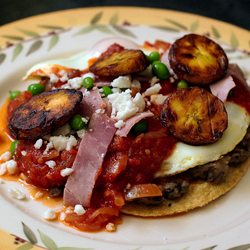 Two weekends ago, we ran into our friend Jeanne at the farmers market, as we often do. Jeanne had just returned from an East Coast trip, so we had a lot of catching up to do. But after chatting in the summer sun for a while, Cameron and I started to get antsy: We had to get home to start curing pork belly, the first step in making a batch of homemade bacon. Hearing this, Jeanne mentioned she’d always wanted to make her own bacon, but didn’t have the space for a smoker. “We have a smoker you can borrow whenever you want,” we offered. “Or, you could just come over next weekend, and smoke some bacon with us.”
Two weekends ago, we ran into our friend Jeanne at the farmers market, as we often do. Jeanne had just returned from an East Coast trip, so we had a lot of catching up to do. But after chatting in the summer sun for a while, Cameron and I started to get antsy: We had to get home to start curing pork belly, the first step in making a batch of homemade bacon. Hearing this, Jeanne mentioned she’d always wanted to make her own bacon, but didn’t have the space for a smoker. “We have a smoker you can borrow whenever you want,” we offered. “Or, you could just come over next weekend, and smoke some bacon with us.”
Jeanne is nothing if not determined: When she discovered that none of the farmers market vendors had any pork belly left, she scoured the City for a piece, so she could cure her own batch at home. Knowing that Jeanne and Cameron share a devotion to the Red Sox, I set the bacon-smoking time so that we could all listen to the game together: 10am Sunday. With pork curing in two fridges and the schedule nailed down, our discussions turned to more important things: What should we make for brunch?
“What do you think about huevos motuleños?” asked Jeanne, linking to her own recipe for the classic Mexican egg plate. “I think your fondness of things Mexican equals mine!” (She knows us well — it took me all of 30 seconds to agree.)
So last Sunday, Jeanne arrived right at 10am, with a bundle of cured pork belly, a bottle of homemade hibiscus-lemongrass agua fresca, and a ripe plantain. After we’d loaded up the smoker and dialed in the temperature, we popped back into the kitchen to finish up our brunch. As the sauce warmed, I refried the beans and crisped the tostadas; Cameron fried three sets of over-easy eggs to perfection (all at the same time!); and Jeanne sauteed the plantains and poured tall glasses of delicious agua fresca. Everything came together at just the right time — amazing what you can make happen when three avid cooks share the work. And so, as the smell of applewood began wafting in from the backyard, we sat down to a colorful and delicious Mexican brunch.
Despite its international origins, our team effort made a perfect One Local Summer feast. With the exception of the fried plantains — I claim a brunch-guest exemption! — everything in our meal came from local sources. It took a little creativity (substituting a salty local feta for Mexcian queso fresco) and a few extra steps to keep things locavore-friendly; you could certainly simplify things by using canned black beans and store-bought tostada shells if you weren’t as set on having an all-local feast.





Huevos Motuleños
— adapted from World on a Plate
1-1/2 pounds ripe tomatoes
1 medium white onion, thinly sliced (divided use)
3 serrano chiles, cut into strips
—
1 ripe plantain, peeled and cut into 1/2-inch slices (optional)
2 cloves garlic, diced
1 to 2 cups black beans and their liquid
3 oz ham, cut into matchsticks or small dice
1/2 cup fresh peas, blanched or quick-braised
1 oz (about 1/4 cup) crumbled queso fresco or firm feta
8 eggs
4 corn tortillas
Roast the tomatoes on a rimmed baking sheet, 4 inches below a very hot broiler, until blistered and blackened, flipping to cook both sides. Cool tomatoes in a bowl, then peel while catching all the juices over the bowl. Coarsely puree the tomatoes and juice using a stick blender or in a food processor.
In a medium saucepan, heat 1T oil over medium heat. Add about 3/4 of the onion and saute, stirring regularly, until onions golden, about 8 minutes. Add the tomatoes and chile strips and simmer over medium-low heat for 15 minutes or so, stirring often, until the sauce is beginning to thicken but is still juicy. Season with salt to taste, and remove from heat to let the chiles steep.
(At this point, you can cool and refrigerate the sauce overnight.)
Pour a 1/2-inch depth of oil in a shallow skillet or frying pan. Warm the pan over medium heat until the oil shimmers. Add tortillas, one at a time, and cook until golden; flip with tongs and crisp the other side, then drain on a wire rack over newspaper or over a cookie sheet. Repeat with remaining tortillas until all are toasted.
Pour off most of the oil, reserving some (2T or so) for frying the beans, and leave about a tablespoon in the pan. Return to the heat, and lay the plantain slices in a single layer. Cook for 3 to 4 minutes per side until richly browned. Sprinkle with salt as soon as you take them out of the oil, then drain on paper towels and hold in a warm oven.
Add the reserved oil to the pan, and saute the remaining onions until golden and soft. Add the diced garlic and cook for another minute or two. Add the beans and a spoonful of their cooking liquid to the pan. Mash with a potato masher until beans are soft but some texture remains. Add more liquid as needed to achieve a spreadable texture, and keep warm, covered, over very low heat.
Mix together the ham strips and the peas in another small pan or dish, and warm gently over low heat. Crumble the cheese into a small bowl and set aside. Remove the chile strips from the tomato sauce, and set the pan of sauce over low heat to rewarm.
Finally, fry the eggs using your preferred method. (Traditionally, you want a runny yolk, so sunny-side up or over easy.) Spread some of the beans over each tostada, slide an egg on top, drizzle the tomato sauce over and around the eggs, letting it run off the tostada and on to the plate. Sprinkle each portion with the ham, peas and cheese. Serve immediately.
Farmers and food artisans who created the ingredients for this week’s meal: Bruins Farm
Bruins Farm, Winters: Tomatoes
Catalán Family Farm, Hollister: Onions
Chue’s Farm, Fresno: Serrano chiles & garlic
Rancho Gordo, Napa: Black beans
Boccalone, Oakland: Ham (proscuitto cotto)
Iacopi, Half Moon Bay: Shelling peas
Spring Hill Cheese Company, Petaluma: Goat feta
Eatwell Farm, Dixon: Pastured eggs
Primavera, Sonoma: Corn tortillas
Bariani, Sacramento: Olive oil
…plus our own homegrown
epazote for the beans
breakfast, locavore, Mexican, One Local Summer
4 Comments »




Posted by Anita on 02.17.09 11:46 PM
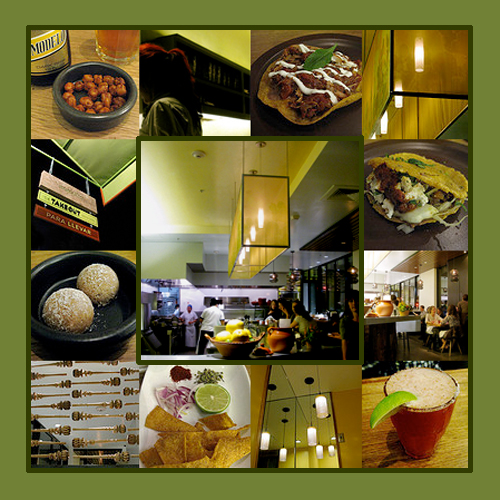
I don’t think it’s any secret here that we’re big fans of puns, wordplay, and other clever banter, so you’ll probably guess that I’ve been gaga about the wittly named Nopalito — the casual Mexican offspring of our beloved Nopa — since the day I first learned it was coming to town.
It’s also no great surprise that an authentic Mexican restaurant would be a huge draw for me, the girl who would happily scarf chilaquiles for breakfast, tortas for lunch, and a big cheesy combination platter for dinner. But here’s the icing on the cake: Nopalito follows the same local-seasonal-sustainable-organic-ethical blueprint as its older sibling, and it does it in style.
Now, we’re not much for restaurant reviews these days, but I will say this: Nopalito is off to a running start, and we’re looking forward to many return trips. As Cameron said: “This place is pretty much the restaurant you’ve been waiting for… forever.” He’s right: There’s very few places like Nopalito in the Bay Area — Doña Tomas is about the nearest equivalent — and certainly nothing of its type within The City proper.
 Do I like the hour-long waits? No. (But I’m soothed by being able to call ahead and put my name on the list.) Do I like perching on barstools, elbow-to-elbow with perfect strangers at a communal table? Not one bit. (But on the other hand, it’s prime Eatsdropping territory, and a not-bad way to decide what you want to order next.) Am I enthralled with everything I ate on our first visit? Not by a long shot.
Do I like the hour-long waits? No. (But I’m soothed by being able to call ahead and put my name on the list.) Do I like perching on barstools, elbow-to-elbow with perfect strangers at a communal table? Not one bit. (But on the other hand, it’s prime Eatsdropping territory, and a not-bad way to decide what you want to order next.) Am I enthralled with everything I ate on our first visit? Not by a long shot.
But there were enough promising tastes on our first visit — the gordita de picadillo first among them — that absolutely transported me. I’m looking forward to seeing what else they have in store, especially once the weather warms up enough to enjoy a Michelada or two on the covered patio.
Nopalito
306 Broderick Street
(x Fell/Laguna)
San Francisco, CA
415-437-0303
Dark Days challenge, locavore, Mexican, restaurants
5 Comments »




Posted by Anita on 11.19.08 11:31 PM
 What do you do when one of your favorite foodies comes to town, and specifically mentions wanting to stroll through The Mission? Why, you plan an itinerary that takes you past some of the neighborhood’s favorite places to buy delicious treats!
What do you do when one of your favorite foodies comes to town, and specifically mentions wanting to stroll through The Mission? Why, you plan an itinerary that takes you past some of the neighborhood’s favorite places to buy delicious treats!
After shopping our way through the Ferry Plaza Farmers Market together, we left Laura to explore on her own for a few hours. (We hit Rainbow Grocery for a few staples, then headed home to put our perishables in the fridge.) We met up at high noon at 16th Street BART. Seeing as how it had been ages since we stuffed ourselves with Mexican breakfast at Primavera, we decided a traditional San Francisco burrito was in order. We stopped at Taqueria El Castillito — an old favorite, but definitely not local, sustainable, or organic in any way — and fortified ourselves with burritos and a torta, and a few bottles of Mexican cane-sugar sodas.
Back out into the bright sunshine — it’s always sunny in The Mission, but Saturday was unseasonably hot — we trekked down Mission to 18th. Trying to keep to the shady side of the street, we pointed out the retaurant row that is 18th and Guerrero (Farina, Tartine Bakery, Delfina, and Pizzeria Delfina) but did not stop to join the monster queues. We’d really just planned to peek into Bi-Rite Creamery, but the short line — full of surprisingly happy ‘No on 8‘ protesters — and list of fabulous flavors tempted us. We couldn’t let Laura leave San Francisco without a taste of the famous Salted Caramel ice cream, could we? (Cameron also sampled the malted vanilla with peanut brittle, just to make sure we’d covered all the bases.)
Across the street, Bi-Rite Market was sampling their Thanksgiving offerings from a catering station on the sidewalk. We smelled the heavenly aromas, but couldn’t even consider a nibble. We pressed inside the store along with everyone else in the entire neightborhood, taking a peek at all the fabulous local produce and the justifiably famous deli case. (I still don’t understand how Sean and DPaul lived around the corner for years without weighing 300 pounds. I’d never cook!)
Backtracking to Valencia Street, we strolled past Range — where we’d enjoyed a fabulous dinner the previous night — and popped into Lucca, one of the last remaining vestiges of the Mission’s Italian heritage. We browsed the aisles, admiring the terrific assortment of goodies, then headed back out into the street. I think I always knew that Lucca makes their ravioli on the premises, even noted the minuscule factory visible through the picture window along Valencia, but I’d never timed it right to see the process in action until this week. We stood with our noses pressed to the glass for what must have been half an hour, watching as a pair of flour-dusted pasta makers heaved giant wads of dough through an industrial sheeter, then picked them up like so much dirty laundry and magically unfolded them along a table the size of most San Francisco living rooms. (I could descibe the whole process, but Laura’s slideshow does a much better job.)
We picked up the pace and continued down Valencia to 23rd, then down Mission to 24th. After a quick stroll through the Mexican produce stalls and flower shops, we stopped into Philz to let Cameron caffeinate himself with a fine Turkish-style fiter-drip blend, while Laura and I rested our eyes and feet in the cool, dim surroundings.
Our last stop took us to a rendezvous with some of our fellow bloggers at Mission Pie. We were nearly stuffed, but somehow made room to share a slice of double-crust apple pie and another of pear-raspberry galette. When Jen arrived, she showed us the error of our ways, generously offering nibbles of the godly walnut pie (with a gooey center like pecan pie); I now understand why people drive across town to buy a slice. We sat at a big table together in the now-waning afternoon sun, marveling at all the shop’s gorgeous, quirky details — a map of the farms that sell their produce to the pie-makers, a collection of antique egg scales, and some of the coolest light fixtures in the city — chatting about everything from Yves St. Laurent to antique tractors to …well, food, of course.
If we’d only had an extra stomach, we could have kept walking all day.





Taqueria El Castillito
2092 Mission Street (x17th)
San Francisco, CA 94110
415.621.3428
Bi-Rite Creamery
3692 18th Street (x Dolores)
San Francisco, CA 94110
415.626.5600
Bi-Rite Market
3639 18th Street (x Dolores/Guerrero)
San Francisco CA 94110
415.241.9760
Lucca Ravioli Company
1100 Valencia Street (x 22nd)
San Francisco, CA 94110
415.647.5581
Philz Coffee
3101 24th Street (x Folsom)
San Francisco, CA 94110
415.875.9370
Mission Pie
2901 Mission Street (x 25th)
San Francisco, CA 94110
415.282.4PIE
coffee & tea, dessert, Italian, Mexican, other blogs, The Mission
7 Comments »




Posted by Anita on 11.03.08 11:00 PM
 Last year, I found myself green with envy — if you’ll pardon the pun — over Dylan’s stores of tomatillo salsa. By the time I cleared some space on the canning calendar, though, all the Ferry Plaza farmers who normally sell tomatillos (which isn’t a long list to begin with) had finished their harvest for the season.
Last year, I found myself green with envy — if you’ll pardon the pun — over Dylan’s stores of tomatillo salsa. By the time I cleared some space on the canning calendar, though, all the Ferry Plaza farmers who normally sell tomatillos (which isn’t a long list to begin with) had finished their harvest for the season.
So when I saw the saw the first basket of tomatillos early this summer, I pounced. After a long winter without a steady supply of chili verde, green posole, or even a simple tomatillo salsa, I was long overdue. But I put off making salsa again, for reasons I can’t quite explain.
Luckily, the tomato and tomatillo season this year seems to be going on forever, and despite my folly, was able to score a big 5-pound bag at Catalán Family Farm‘s market stand on Saturday, and put up a full batch of liquid green love on Sunday afternoon.
I feel more relaxed already, I tell ya.
To my palate, the best, most flavorful tomatillos — especially in salsas, where their flavor is so distinct — are the small, purple-tinted milperos. Ranging in size from cherry-tomato-ish to itty-bitty pea-sized, out of the husks milperos look like a bag of marbles. Most are green, a few are white, some are deep purple, but the beauties of the crop are almost pearlescent, with swirls of lavender and sage. Alas, the colors turn to a uniform green as soon as they’re heated, but their intense flavor lingers on. Even their husks are pretty; the veins are purplish against a khaki-colored lace.
We celebrated Dia de los Muertos yesterday by eating Primavera green-chile tamales with our fresh batch of homemade tomatillo salsa and a dollop of rich organic, local sour cream. Yum.
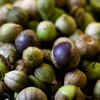
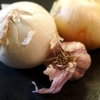



This salsa smells impossibly sour while you’re cooking it down, but fret not… all will be well when the simmering is done. Don’t be tempted to skimp on the acids; they’re necessary for safely preserving this naturally low-acid food.
Tomatillo Salsa
makes 6 half-pint jars
3 pounds tomatillos, chopped (weight after husking and washing)
1-1/2 cup chopped onion
5 serrano chiles, minced (not seeded or deveined, unless you want a milder salsa)
1 medium fresno or red jalapeño, minced (not seeded or deveined)
6 cloves garlic, minced
1T ground cumin
3/4 tsp salt
1/4 cup cider vinegar
1/4 cup lime juice
Prepare a boiling-water canner: Fill it half full of water and heat to a simmer. Keep canning jars and lids warm in simmering water.
Combine all salsa ingredients in a large saucepan. Bring to a boil, then reduce heat and simmer 10 minutes. Pass the simmered salsa through a food mill fitted with the largest disc.* Return the milled salsa to pan and bring back to a simmer. Adjust salt and seasoning as needed.
Ladle hot salsa into clean, hot jars, leaving 1/2-inch headspace; remove air bubbles and wipe rim. Center hot lid on jar; apply band and adjust until fit is fingertip tight.
Place the filled jars in the canner, and bring to a rolling boil. Process at a full boil, uncovered, for 15 minutes. At the end of processing time, turn off heat and raise the canning rack to the upper level and let jars sit above the water for ~5 minutes to gradually stop boiling. Remove jars to a cooling rack, and leave undisturbed until thoroughly cool. Check lids for seal after 24 hours. Lid should not flex up and down when center is pressed.
* Note: You don’t want to use a food processor in place of the food mill, as it will whip air into the salsa, which could end up trapped as trapped bubbles during canning. If you don’t have a food mill, just be sure to chop everything very fine before cooking and enjoy the chunkier texture of your salsa.
Mexican, preserving & infusing, recipes
12 Comments »




Posted by Anita on 11.02.08 8:48 PM
 I must be getting old, because I actually just said out loud: “Where has the year gone?” Really, people, can I get an amen here? Doesn’t it seem like 2008 has just screamed on by? (And yet, somehow, Election Day seems like it might never come.) I don’t want to get ahead of myself, but the holidays are really right around the corner, with Halloween just past and everyone’s favorite feast less than a month away. And today’s a holiday, too: Dia de los Muertos.
I must be getting old, because I actually just said out loud: “Where has the year gone?” Really, people, can I get an amen here? Doesn’t it seem like 2008 has just screamed on by? (And yet, somehow, Election Day seems like it might never come.) I don’t want to get ahead of myself, but the holidays are really right around the corner, with Halloween just past and everyone’s favorite feast less than a month away. And today’s a holiday, too: Dia de los Muertos.
I feel like I’m repeating myself a little here — we talked about marigolds, sugar skulls, and La Catrina last year. But really, there’s so much more to enjoy, so many more wonderful food traditions that go along with this fiesta. After all, the idea behind the Dia de los Muertos ofrendas — the memorial altars to loved ones — is that the living tempt the spirits of loved ones to pay a visit by putting out their favorite foods, drinks, and other little mementos of the things they loved in life.
Last year, I took a day off from work and brought home a whole table’s worth of treats. This year, the weekend snuck up on me; the best I could manage was relocating a flowering houseplant (not quite marigolds, but hey, at least they’re orange), and adding a few things I know my Dad loved: A jar of home-made tomatillo salsa, a shaker of Tabasco-flavored seasoning salt, and the little greyhound calaca figurine — Dad would never travel anywhere without his dogs.
Almost as much as he loved greyhounds and spicy food, Dad loved sweets. I knew the ofrenda couldn’t do without pan de muertos, the rich, eggy bread made just for the occasion. But I had no time to head to the Mission, and with Eat Local Challenge just wrapping up it didn’t seem right to buy a loaf filled with goodness knows what.
My first attempt at homemade pan de muertos was a qualified success; tasty, but flawed. I can almost hear Dad telling me, as he always did, that I am being too critical of my own efforts: “Neen, it looks great. I don’t know what you’re talking about.” (And he’d be right… it really does look fine, just not like I expected, and definitely not like store-bought.)
The nice thing about pan de muertos — and all of the tempting treats laid out on the ofrendas — is that they’re just as much for the living as for the deceased. Hooray, we get to eat it, too! And even though I know that the holiday is supposed to be filled with happiness and fond memories, this year I’m happy to have a little extra bit of comfort to help me get in the festive mood.
You see, this year we’re also remembering our friend Briana Brownlow in our celebrations. Bri passed away just last week, at the impossibly young age of 31, after a hard-fought battle against cancer. Though we met her in person only once, we knew her well as one of those people who makes everyone’s life online a little brighter. Even in the midst of her cancer’s recurrence, it was a joy to see Bri’s optimism, and her obvious joy as friends offered support through food (and a food-bloggers’ fundraiser).
Tomorrow morning, when I toast up a piece of the leftover pan — looking out at the bright yellow of our lemon tree in the otherwise grey, rainy yard — I’ll smear it with some of the citrus curd I made from our backyard fruit and remember the woman whose strength inspired so many.





Alas, no recipe today. I’d planned to share my variation on Diana Kennedy’s pan de muertos, but something went awry. Not badly enough to keep us from eating the bread, but odd enough to keep me from unleashing the recipe on you. The “bones” melted into the main body of the bread, and the whole thing came out far too flat and wide; I think I must have miscounted egg yolks or mis-measured butter. It still tastes fabulous, though… it just doesn’t really look the way it ought.
But don’t let that discourage you from giving it a whirl. Although it’s a time-consuming recipe that calls for fussy things like overnight rises in the fridge and multiple buttered sheets of waxed paper, it’s a very forgiving dough that’s a lot of fun to make.
baking, family, holidays & occasions, Mexican, other blogs
1 Comment »




Posted by Anita on 06.22.08 4:30 PM
 One day last week, I looked up from my work and was stunned to see it was nearly 2:30 in the afternoon. The day had screamed away from me, and — not surprisingly — I was ravenous.
One day last week, I looked up from my work and was stunned to see it was nearly 2:30 in the afternoon. The day had screamed away from me, and — not surprisingly — I was ravenous.
Local food choices near my office are pretty bleak, so I try to eat pescitarian when I can’t determine the source of my lunchtime chow. It’s an easy choice to make, since the mall near my office is home to one of the Bay Area’s only outposts of Rubio’s, a SoCal chain of Baja-style joints. Their #1 combo plate — two fish tacos and a side of frijoles — makes a reliable lunch in a pinch.
Usually, that is.
Unfortunately, the tacos I got that afternoon were pretty bad: The tortillas were falling apart, and the fish was smelly and dark. I pulled the offending meat out and ate my tacos veggie style, resolving to remember to bring my lunch the next day.
Rather than put me off, the whole experience just made me crave fish tacos — real ones, good ones — all the more. So come Saturday, we stopped by Shogun Fish at the Ferry Plaza farmers market and picked up a nice fillet of black rockfish caught off the Mendocino coast. I figured we’d be out of luck for local cabbage, but we found a gorgeous head over at Tierra‘s stand, where we also picked up a bag of super-smoky chipotles. Add in a pack of Rancho Gordo tortillas and a tub of Primavera salsa, and we were good to go.
Even if you think you don’t like seafood, a Baja-style fish taco is pretty easy to love. There’s not really anything mysterious about them: Batter-fried fish, wrapped in a corn tortilla, topped with shredded cabbage, salsa, and creamy white sauce.
To drink? Well, there isn’t a much better local alternative that good old Anchor Steam, brewed about 2 miles from our house. We used it in the fish batter, too, along with Guisto‘s flour, Stonehouse olive oil, and a Marin Sun Farms egg white. The traditional salsa blanca combines equal parts Clover Organic sour cream and home-made mayonnaise (from the same local eggs and oil), spiced up with the Tierra chipotles.
The result: My favorite kind of summertime food — good ingredients, simply prepared.





Baja-Style Crispy Fish Tacos
adapted from The River Cottage Cookbook
– fish:
1 large fillet of firm, white fish (about 12 ounces)
scant 2/3 cups all-purpose flour
1T olive oil
up to 6oz beer, as needed
1 egg white
oil, for frying
 – white sauce:
– white sauce:
1/3 cup mayonnaise
1/3 cup sour cream
1 or 2 chipotle chiles (canned or dry)
– to serve:
corn tortillas
1/4 head of cabbage, shredded fine
prepared salsa or taco sauce
cilantro sprigs, if desired
Mix the flour with oil, then thin it with beer to the consistency of thick paint. Season with salt and pepper, and leave at room temperature for at least an hour while you prep your other ingredients.
Cut your fish into 1-1/2-inch strips, against the grain of the fillet. Season with salt and pepper on both sides, and set aside.
For the white sauce, combine the mayo and the sour cream. If using dry chipotles, soak them in hot water for 15-20 minutes until soft, then chop to a fine paste with kosher salt. For canned chipotles, a simple mashing will do. Add the chipotle paste, to taste, to the sour cream-mayo mixture; season with salt as needed.
Heat oil in a deep-sided kettle or dutch oven to 350°.
Whip the egg white until frothy, then fold into the rested fish batter. Dip the fish pieces in the batter, shaking off any excess, and gently lower them into the hot oil. (You may need to work in multiple batches to avoid crowding the pan; be careful not to allow the oil temperature to drop.) When golden brown, remove from the oil with a spider or slotted spoon. Place the fish on a wire rack over old newspaper while you fry the remaining pieces.
To serve, place a piece of fish in the center of a tortilla; top with white sauce, salsa, cilantro, and shredded cabbage as desired.
farmers markets, locavore, Mexican, One Local Summer
15 Comments »




 The first glimmers of spring are showing up at the farmers market, just as we’re on the home stretch of the Dark Days Challenge, and boy are we excited. Not so much for the strawberries; they’re still white in the center, and I’ll happily wait until they’re fully ripe. But we’re gorging ourselves on the new, tender asparagus, and we’re definitely making up for lost time in the avocado department.
The first glimmers of spring are showing up at the farmers market, just as we’re on the home stretch of the Dark Days Challenge, and boy are we excited. Not so much for the strawberries; they’re still white in the center, and I’ll happily wait until they’re fully ripe. But we’re gorging ourselves on the new, tender asparagus, and we’re definitely making up for lost time in the avocado department. Farmers and food artisans who created the ingredients for this week’s meal:
Farmers and food artisans who created the ingredients for this week’s meal:









































 Last year, I found myself green with envy — if you’ll pardon the pun — over
Last year, I found myself green with envy — if you’ll pardon the pun — over 
















 – white sauce:
– white sauce: